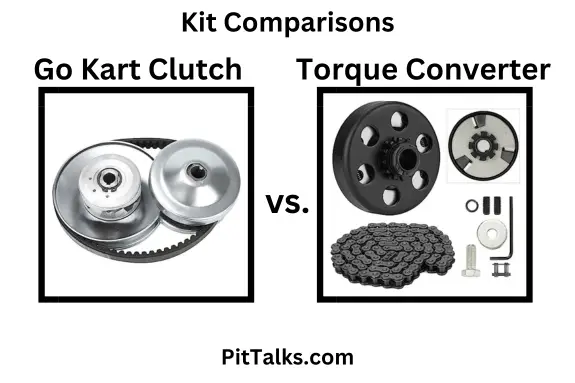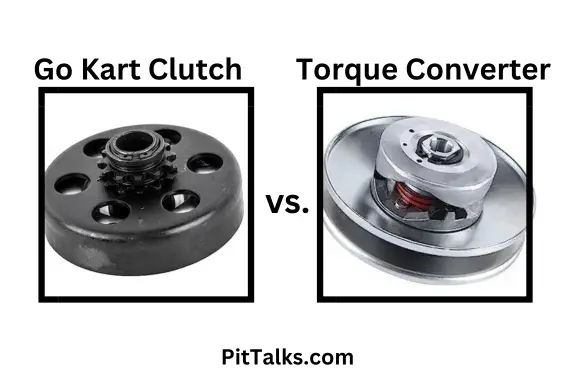Last Updated on September 23, 2023 by Pittalks
For go-kart enthusiasts or those aspiring to become one, the choice between a torque converter and a clutch is a crucial one. The decision could significantly impact the performance of your kart, particularly in terms of acceleration, speed, and operational efficiency. Therefore, understanding the core differences, advantages, and drawbacks of each is essential. This article will provide an in-depth comparison of a torque converter vs clutch for a go-kart, aiming to empower you with the knowledge to pick the option that best suits your needs.
Understanding the Basics: What is a Clutch?
A clutch in a go-kart is a mechanical device designed to engage and disengage the power in the transmission, specifically from the driving shaft to the driven shaft. In simple terms, it acts as a bridge connecting your engine to the wheels. It controls the power flow between them, particularly during gear changes.
Components of a Clutch
A clutch in a go-kart primarily consists of the following components:
- Outer Drum: This acts as the casing for the interior components.
- Drive Sprocket: It helps in connecting the rear axle through a roller chain.
- Friction Material: It helps in the engagement and disengagement of the clutch.
- Arrestor Spring: It holds the internal components in place, preventing them from making contact with the drum.
The operation of a go-kart clutch revolves around centrifugal force. When the engine’s RPM (Revolutions Per Minute) reaches around 1,400 to 1,600, the centrifugal force becomes strong enough to push the friction material outward, causing the clutch to slip. However, the clutch does not fully engage until the RPM reaches around 1,800.
Digging Deeper: What Does a Go-Kart Torque Converter Do?
A go-kart torque converter, similar to a clutch, is a mechanism that helps in transmitting power from the engine to the wheels. However, unlike a clutch, a torque converter operates on a Continuously Variable Transmission (CVT) principle, meaning it has a variable gear ratio and can adjust according to the torque requirement.
Components of a Torque Converter
A torque converter consists of the following components:
- Housing: It contains all other components.
- Impeller: It is connected to the engine and helps in transferring the engine’s power.
- Turbine: It connects to the transmission and receives the power transferred by the impeller.
- Transmission Fluid: It facilitates the power transfer between the impeller and the turbine.
- Stator: It multiplies torque as the fluid moves back towards the impeller from the turbine.
Comparing the Two: Torque Converter vs Clutch

Now that we have a basic understanding of what a torque converter and a clutch are, let’s delve into a comparison between the two. I’ll leave a go kart clutch vs torque converter comparison table below, and then I’ll dive deeper into detail on a few important points.
| Aspect | Go Kart Torque Converter | Clutch |
|---|---|---|
| Driving Method | Automatic | Manual |
| How They Work | Uses a fluid coupling system to transfer power between the engine and the drive wheels. The system automatically adjusts the gear ratio based on engine RPM, allowing the engine to stay in its powerband and providing smoother acceleration. | Directly connects and disconnects the engine from the drive wheels using friction. The driver manually engages and disengages the clutch to change gears and control power transmission. |
| Applications | Recreational go karts, utility go karts, golf carts, and some small vehicles where automatic transmission is preferred for ease of use and smooth acceleration. | Racing go karts, high-performance vehicles, motorcycles, and manual transmission cars where precise control over gear changes and engine response is crucial for optimal performance. |
| Benefits | 1. Automatic Operation: Easier to drive as there is no need for manual gear shifting or clutch control, making it beginner-friendly and accessible to a wide range of users. | 1. Manual Control: Allows skilled drivers to optimize gear changes for better performance, especially in racing or high-performance applications. |
| 2. Smooth Acceleration: Offers smoother acceleration due to the continuously variable gear ratio, which eliminates the need for clutch engagement during take-off. | 2. Efficiency: Direct mechanical connection ensures minimal power loss, resulting in better fuel efficiency and overall performance. | |
| 3. Reduced Stalling: The torque converter’s fluid coupling prevents stalling, which is particularly beneficial for novice drivers who may struggle with clutch control. | 3. Simplicity: Simpler design and fewer moving parts make clutches more reliable and easier to maintain. | |
| 4. Less Wear and Tear: The automatic nature of torque converters reduces wear on the engine and transmission components, leading to extended lifespan. | 4. Immediate Response: Clutches offer faster response times as power is directly transmitted without the fluid coupling delay, making them ideal for quick gear changes. | |
| Disadvantages | 1. Lower Efficiency: The fluid coupling in torque converters can lead to some power loss, resulting in slightly lower overall efficiency compared to a direct mechanical connection. | 1. Skill Requirement: Operating a clutch demands coordination and practice, making it more challenging for inexperienced drivers or those not familiar with manual transmission. |
| 2. Less Precise Control: While torque converters provide smooth acceleration, they may not offer the same level of precision as a clutch when it comes to gear changes and power modulation. | 2. Stalling Risk: Inexperienced drivers may stall the engine if they don’t properly engage or disengage the clutch. | |
| Common Use Cases | 1. Recreational Use: Go karts designed for casual riding and family entertainment, where user-friendly operation is a priority. | 1. Performance Driving: Racing applications, high-performance cars, and motorcycles where drivers need full control over gear changes and power delivery. |
| 2. Utility Vehicles: Golf carts, utility go karts, and other small vehicles used for transportation within closed environments or campuses. | 2. Economic Transportation: Many economical passenger cars use manual transmission with a clutch to provide good fuel efficiency and driving experience. | |
| 3. Off-Road Fun: Some off-road go karts or recreational vehicles utilize torque converters for their ease of use and smooth ride. | 3. Towing Capacity: Vehicles with manual transmission and a clutch are often preferred for towing heavy loads due to better control over power delivery. | |
| Conclusion | Go kart torque converters offer convenience, smooth acceleration, and reduced stalling risk, making them ideal for recreational and utility applications. They are great for beginners or situations where automatic operation is preferred. On the other hand, clutches provide precise control, better efficiency, and are a must-have for performance driving or situations where drivers seek maximum control over gear changes. The choice between the two depends on the specific application and the driver’s skill level. | In conclusion, the choice between a go kart torque converter and a clutch depends on the specific application and the driver’s preference and skill level. Each has its own advantages and disadvantages, making them suitable for different scenarios. Ultimately, torque converters are more user-friendly and automatic, while clutches offer more precise control and efficiency for skilled drivers. |
Operational Differences
The operational principles of a torque converter and a clutch are starkly different. A torque converter starts to engage at around 1,700 RPM. It has a variable gear ratio and can handle low torque ranges better due to its ability to disengage easily at lower RPMs.
On the other hand, a clutch engages earlier, around 1,400 to 1,600 RPM, and fully engages at 1,800 RPM. However, it operates at a fixed gear ratio and is more apt for high-speed situations where the kart is constantly engaged at the upper torque range.
Cost and Maintenance
While torque converters are generally more expensive than clutches due to their more complex design and additional parts, they may prove to be more cost-effective in the long run. This is primarily because they result in less wear and tear on the engine, translating to lower maintenance costs.
On the contrary, clutches are cheaper initially but can lead to higher maintenance costs over time due to increased wear and tear, especially if not properly lubricated.
Performance
In terms of performance, a torque converter is ideal for off-road go-karts requiring lower-end torque and variable gear ratios. It is also better in situations involving a lot of stop-and-go.
On the other hand, a clutch is more suitable for racing go-karts that require high speed and constant engagement. It delivers higher top speed and better acceleration, making it ideal for flat tracks.
Centrifugal Clutch vs CVT Torque Converter Comparison Video
Deciding the Better Option: Torque Converter or Clutch?
Choosing between a torque converter and a clutch largely depends on the type of go-kart you have and the terrain you usually drive on. For instance, if you have an off-road go-kart and often drive on rough terrains, a torque converter would be a more suitable choice due to its ability to handle lower-end torque and offer variable gear ratios.
However, if you own a racing go-kart and mostly drive on flat tracks, a clutch would be the better option as it can deliver higher top speed and better acceleration.
Wrapping Up
In conclusion, both torque converters and clutches have their own sets of advantages and disadvantages, making them suitable for different types of go-karts and driving conditions. Therefore, the choice between a torque converter vs clutch for a go-kart ultimately boils down to your specific requirements.
Remember, understanding your go-kart’s mechanics and how you intend to use it is the key to making an informed decision. Whether you choose a torque converter or a clutch, ensure that it aligns with your go-kart’s specifications and your driving habits for the best performance.
FAQs and Related Questions
A go kart torque converter is a device that transfers power from the engine to the drive wheels using a fluid coupling system. It automatically adjusts the gear ratio based on engine RPM, providing smooth acceleration without manual gear shifting or clutch control.
A clutch in a go kart offers manual control over gear changes and power transmission. Skilled drivers can optimize gear shifts for better performance, while direct mechanical connection ensures minimal power loss and improved efficiency.
For racing go karts, a clutch is preferred. It allows experienced drivers to optimize gear changes for maximum performance, with immediate response and better efficiency compared to torque converters.


